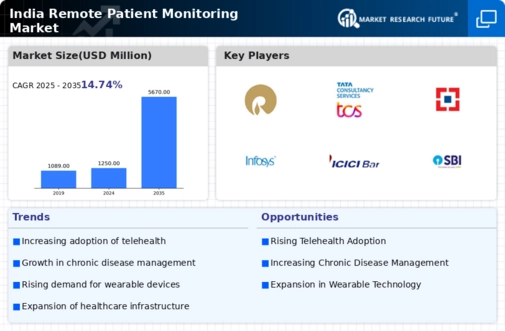Rising Healthcare Costs
The escalating costs associated with healthcare services in India are significantly influencing the remote patient-monitoring market. As healthcare expenses continue to rise, both patients and providers are seeking cost-effective alternatives to traditional care models. Remote monitoring technologies offer a viable solution by reducing the need for frequent hospital visits, thereby lowering transportation and treatment costs. Reports indicate that remote monitoring can potentially reduce hospital readmission rates by up to 30%, leading to substantial savings for healthcare systems. This financial incentive is likely to drive the adoption of remote patient-monitoring solutions, as stakeholders aim to optimize resource allocation while maintaining quality care. Thus, the rising healthcare costs are a critical driver for the remote patient-monitoring market, prompting a shift towards more efficient care delivery models.
Government Initiatives and Support
Government initiatives aimed at enhancing healthcare access and quality are playing a crucial role in the growth of the remote patient-monitoring market. In India, various policies and programs have been introduced to promote telemedicine and digital health solutions, thereby facilitating the adoption of remote monitoring technologies. The Ministry of Health and Family Welfare has launched initiatives to integrate telehealth services into the national healthcare framework, which is expected to expand the reach of remote patient monitoring. Additionally, financial incentives and subsidies for healthcare providers adopting these technologies may further stimulate market growth. As a result, government support is likely to be a significant driver for the remote patient-monitoring market, fostering an environment conducive to innovation and improved patient care.
Increasing Demand for Home Healthcare
There is a notable surge in demand for home healthcare services in India. This trend is driven by a growing preference among patients for receiving care in the comfort of their homes, which is perceived as more convenient and less stressful than traditional hospital visits. According to recent estimates, the home healthcare market in India is projected to reach approximately $6 billion by 2025, indicating a robust growth trajectory. This shift towards home-based care is likely to enhance the adoption of remote monitoring technologies, as patients seek to manage their health conditions effectively from home. Consequently, The market is poised to benefit from this increasing demand, as healthcare providers and technology companies develop innovative solutions tailored to home healthcare needs.
Technological Integration in Healthcare
The integration of advanced technologies into healthcare systems is a pivotal driver for the remote patient-monitoring market. In India, the adoption of digital health solutions, including mobile applications and wearable devices, is transforming how healthcare is delivered. These technologies facilitate real-time monitoring of patients' health metrics, enabling timely interventions and personalized care. The Indian government has been actively promoting digital health initiatives, which further supports the growth of the remote patient-monitoring market. For instance, the National Digital Health Mission aims to create a comprehensive digital health ecosystem, which is expected to enhance the accessibility and efficiency of healthcare services. As a result, the technological integration in healthcare is likely to propel the remote patient-monitoring market forward, fostering innovation and improving patient outcomes.
Aging Population and Increased Health Awareness
The demographic shift towards an aging population in India is significantly impacting the remote patient-monitoring market. As the elderly population grows, there is an increasing prevalence of chronic diseases, necessitating continuous health monitoring. Furthermore, heightened health awareness among the general populace is driving individuals to seek proactive health management solutions. This trend is reflected in the rising adoption of remote monitoring devices, which empower patients to take charge of their health. According to projections, the elderly population in India is expected to reach 300 million by 2050, underscoring the urgent need for effective healthcare solutions. Consequently, the aging population and increased health awareness are likely to serve as strong catalysts for the remote patient-monitoring market, encouraging the development of tailored monitoring solutions.

















Leave a Comment